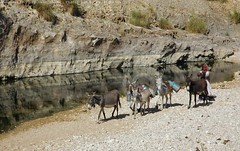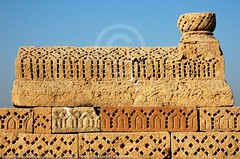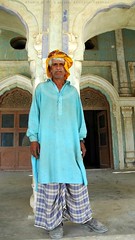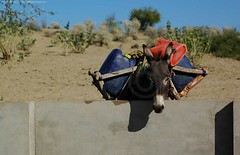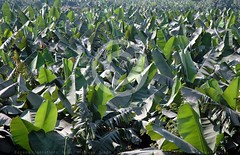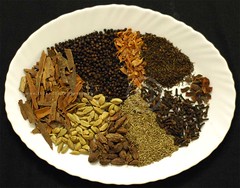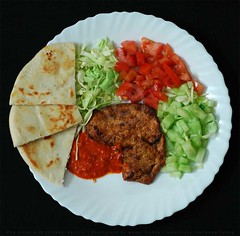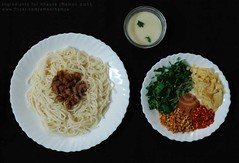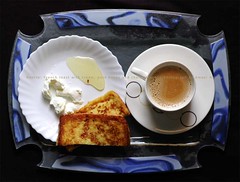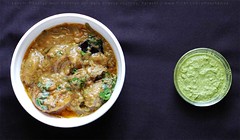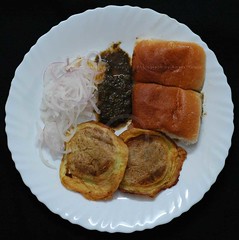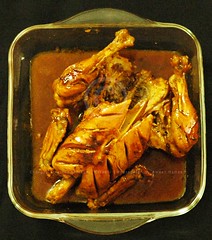Via Flickr:
I found one of the Gabol women herding water from the Runni stream under the shadows of the fort during one of my trips to Rannikot. As a photographer it is a joy to shoot such traditional people going about their age old works.
Wednesday, February 22, 2012
Sunday, February 19, 2012
Chaukhandi tombs near Karachi, Pakistan
Via Flickr:
The Chaukhandi tombs are situated 29 km east of Karachi on N-5 National Highway near Landhi Town in Pakistan. The Chaukhandi tombs are remarkable for the elaborate and exquisite stone carving.
The style of architecture is typical only to the region of Sindh, and unique in that it is found nowhere else in the Islamic world. Generally, the elements are attributed to Jokhio (also spelt Jokhiya) also known as the family graveyard of Jokhio tribe, some people of Baluch tribe also buried were built between the 15th and 18th centuries.
More: en.wikipedia.org/wiki/Chaukhandi_tombs
The Chaukhandi tombs are situated 29 km east of Karachi on N-5 National Highway near Landhi Town in Pakistan. The Chaukhandi tombs are remarkable for the elaborate and exquisite stone carving.
The style of architecture is typical only to the region of Sindh, and unique in that it is found nowhere else in the Islamic world. Generally, the elements are attributed to Jokhio (also spelt Jokhiya) also known as the family graveyard of Jokhio tribe, some people of Baluch tribe also buried were built between the 15th and 18th centuries.
More: en.wikipedia.org/wiki/Chaukhandi_tombs
From the table: Vegetables
Via Flickr:
Fresh vegetables usually found in Karachi this time of the year. Tomato, ginger, French Beans, Green chillies, Potato, beet root, cut onion, cabbage, carrots, lemon, green bell pepper and cauliflower.
Fresh vegetables usually found in Karachi this time of the year. Tomato, ginger, French Beans, Green chillies, Potato, beet root, cut onion, cabbage, carrots, lemon, green bell pepper and cauliflower.
Thursday, February 16, 2012
Water donkey, Thar, Pakistan
Via Flickr:
Water carrier donkey awaits its owner outside the perimeter wall of the government-dug well. These donkeys are very useful creatures in Thar desert area where they carry immense loads of water and construction materials over long distances.
Water carrier donkey awaits its owner outside the perimeter wall of the government-dug well. These donkeys are very useful creatures in Thar desert area where they carry immense loads of water and construction materials over long distances.
Sugar-cane plantation, New Jatoi village, Sindh
Via Flickr:
Sugarcane refers to any of six to 37 species (depending on which taxonomic system is used) of tall perennial grasses of the genus Saccharum (family Poaceae, tribe Andropogoneae). Native to the warm temperate to tropical regions of South Asia, they have stout, jointed, fibrous stalks that are rich in sugar, and measure two to six metres (six to 19 feet) tall. All sugar cane species interbreed, and the major commercial cultivars are complex hybrids.
More: en.wikipedia.org/wiki/Sugar_cane
Sugarcane refers to any of six to 37 species (depending on which taxonomic system is used) of tall perennial grasses of the genus Saccharum (family Poaceae, tribe Andropogoneae). Native to the warm temperate to tropical regions of South Asia, they have stout, jointed, fibrous stalks that are rich in sugar, and measure two to six metres (six to 19 feet) tall. All sugar cane species interbreed, and the major commercial cultivars are complex hybrids.
More: en.wikipedia.org/wiki/Sugar_cane
Banana plantation, Sindh
Via Flickr:
The banana plant is the largest herbaceous flowering plant.[4] The plants are normally tall and fairly sturdy and are often mistaken for trees, but their main or upright stem is actually a pseudostem that grows 6 to 7.6 metres (20 to 24.9 ft) tall, growing from a corm. Each pseudostem can produce a single bunch of bananas. After fruiting, the pseudostem dies, but offshoots may develop from the base of the plant. Many varieties of bananas are perennial.
Leaves are spirally arranged and may grow 2.7 metres (8.9 ft) long and 60 cm (2.0 ft) wide.[5] They are easily torn by the wind, resulting in the familiar frond look.
The banana fruits develop from the banana heart, in a large hanging cluster, made up of tiers (called hands), with up to 20 fruit to a tier. The hanging cluster is known as a bunch, comprising 3–20 tiers, or commercially as a "banana stem", and can weigh from 30–50 kilograms (66–110 lb). In common usage, bunch applies to part of a tier containing 3–10 adjacent fruits.
More: en.wikipedia.org/wiki/Banana_tree
The banana plant is the largest herbaceous flowering plant.[4] The plants are normally tall and fairly sturdy and are often mistaken for trees, but their main or upright stem is actually a pseudostem that grows 6 to 7.6 metres (20 to 24.9 ft) tall, growing from a corm. Each pseudostem can produce a single bunch of bananas. After fruiting, the pseudostem dies, but offshoots may develop from the base of the plant. Many varieties of bananas are perennial.
Leaves are spirally arranged and may grow 2.7 metres (8.9 ft) long and 60 cm (2.0 ft) wide.[5] They are easily torn by the wind, resulting in the familiar frond look.
The banana fruits develop from the banana heart, in a large hanging cluster, made up of tiers (called hands), with up to 20 fruit to a tier. The hanging cluster is known as a bunch, comprising 3–20 tiers, or commercially as a "banana stem", and can weigh from 30–50 kilograms (66–110 lb). In common usage, bunch applies to part of a tier containing 3–10 adjacent fruits.
More: en.wikipedia.org/wiki/Banana_tree
Mango trees, New Jatoi village, Sindh
Via Flickr:
Mango trees (Mangifera indica L.) grow up to 35–40 m (115–130 ft) tall, with a crown radius of 10 m (33 ft). The mango tree is long-lived, as some specimens still fruit after 300 years.[citation needed] In deep soil, the taproot descends to a depth of 6 m (20 ft), with profuse, wide-spreading feeder roots; the tree also sends down many anchor roots, which penetrate several feet of soil. The leaves are evergreen, alternate, simple, 15–35 cm (5.9–14 in) long and 6–16 cm (2.4–6.3 in) broad; when the leaves are young they are orange-pink, rapidly changing to a dark, glossy red, then dark green as they mature. The flowers are produced in terminal panicles 10–40 cm (3.9–16 in) long; each flower is small and white with five petals 5–10 mm (0.20–0.39 in) long, with a mild, sweet odor suggestive of lily of the valley. The fruit takes three to six months to ripen.
More: en.wikipedia.org/wiki/Mango_tree
Mango trees (Mangifera indica L.) grow up to 35–40 m (115–130 ft) tall, with a crown radius of 10 m (33 ft). The mango tree is long-lived, as some specimens still fruit after 300 years.[citation needed] In deep soil, the taproot descends to a depth of 6 m (20 ft), with profuse, wide-spreading feeder roots; the tree also sends down many anchor roots, which penetrate several feet of soil. The leaves are evergreen, alternate, simple, 15–35 cm (5.9–14 in) long and 6–16 cm (2.4–6.3 in) broad; when the leaves are young they are orange-pink, rapidly changing to a dark, glossy red, then dark green as they mature. The flowers are produced in terminal panicles 10–40 cm (3.9–16 in) long; each flower is small and white with five petals 5–10 mm (0.20–0.39 in) long, with a mild, sweet odor suggestive of lily of the valley. The fruit takes three to six months to ripen.
More: en.wikipedia.org/wiki/Mango_tree
Sunday, February 12, 2012
Garam masala ingredients, Karachi
Via Flickr:
Garam masala consists of the following: (From R to L): Green cardamom (choti ilaichi), black cardamom (bari ilaichi), white cumin (safed zeera), cloves (long), star anise (badiyan key phool), black cumin (kala zeera), mace (javatri), black pepper corns (kali mirch) and cinnamon sticks (dar chini / dajh). The only ingredient missing is whole nutmeg. Indian version of Garam Masala (In English: All spice powder) there is an addition of Malabar leaves. In Pakistan, they are generally not found or used in the recipe. All these are mixed in a pan, roasted for 12 minutes, and then grounded to make a fine powder.
Garam masala consists of the following: (From R to L): Green cardamom (choti ilaichi), black cardamom (bari ilaichi), white cumin (safed zeera), cloves (long), star anise (badiyan key phool), black cumin (kala zeera), mace (javatri), black pepper corns (kali mirch) and cinnamon sticks (dar chini / dajh). The only ingredient missing is whole nutmeg. Indian version of Garam Masala (In English: All spice powder) there is an addition of Malabar leaves. In Pakistan, they are generally not found or used in the recipe. All these are mixed in a pan, roasted for 12 minutes, and then grounded to make a fine powder.
A bunch of bananas minus two, Karachi
Via Flickr:
Bananas and plantains constitute a major staple food crop for millions of people in developing countries. In most tropical countries, green (unripe) bananas used for cooking represent the main cultivars. Bananas are cooked in ways that are similar to potatoes. Both can be fried, boiled, baked, or chipped and have similar taste and texture when served. One banana provides about the same calories as one potato.
Bananas are eaten deep fried, baked in their skin in a split bamboo, or steamed in glutinous rice wrapped in a banana leaf. Bananas can be made into jam. Banana pancakes are popular amongst backpackers and other travelers in South Asia and Southeast Asia.
Bananas are an excellent source of vitamin B6 and contain moderate amounts of vitamin C, manganese and potassium.
Along with other fruits and vegetables, consumption of bananas may be associated with a reduced risk of colorectal cancerand in women, breast cancer and renal cell carcinoma.
Main centers of banana production in Pakistan are Hyderabad, Tando Allah Yar & Tando Adam in Sindh province.
Source: en.wikipedia.org/wiki/Banana
Bananas and plantains constitute a major staple food crop for millions of people in developing countries. In most tropical countries, green (unripe) bananas used for cooking represent the main cultivars. Bananas are cooked in ways that are similar to potatoes. Both can be fried, boiled, baked, or chipped and have similar taste and texture when served. One banana provides about the same calories as one potato.
Bananas are eaten deep fried, baked in their skin in a split bamboo, or steamed in glutinous rice wrapped in a banana leaf. Bananas can be made into jam. Banana pancakes are popular amongst backpackers and other travelers in South Asia and Southeast Asia.
Bananas are an excellent source of vitamin B6 and contain moderate amounts of vitamin C, manganese and potassium.
Along with other fruits and vegetables, consumption of bananas may be associated with a reduced risk of colorectal cancerand in women, breast cancer and renal cell carcinoma.
Main centers of banana production in Pakistan are Hyderabad, Tando Allah Yar & Tando Adam in Sindh province.
Source: en.wikipedia.org/wiki/Banana
Wednesday, February 8, 2012
Dinner: Pita bread with chicken and peri peri sauce
Via Flickr:
This dish can only be cooked by my mother. The balance in taste has to match with peri peri sauce ingredients.
This dish can only be cooked by my mother. The balance in taste has to match with peri peri sauce ingredients.
Monday, February 6, 2012
Dinner: Khausa with full ingredients, Karachi
Via Flickr:
Khausa was brought to Pakistan by Jethpur Memons from Burma. They learnt this dish while doing business in Burma and after partition brought it here. Khausa or Khausay, as the dish is known, is usually cooked for dinner but may also be consumed for lunch. It is arguably the best Memoni dish on offer and I have never heard any non-Memon becoming an expert cook of this. It's cooking requires lot of hard work, patience and intricate understanding of the masala and timing for spaghetti boiling. Garlic must always be fried and must come out crisp. Lal mirch must be fresh and so should be coriander leaves as well as chips. If chaat masala is missing or lacking in taste, it will half-destroy the entire taste of the dish. Meat must be cooked in small pieces and eaten as such.
Cooked by my good mother as a gift for all of us.
Khausa was brought to Pakistan by Jethpur Memons from Burma. They learnt this dish while doing business in Burma and after partition brought it here. Khausa or Khausay, as the dish is known, is usually cooked for dinner but may also be consumed for lunch. It is arguably the best Memoni dish on offer and I have never heard any non-Memon becoming an expert cook of this. It's cooking requires lot of hard work, patience and intricate understanding of the masala and timing for spaghetti boiling. Garlic must always be fried and must come out crisp. Lal mirch must be fresh and so should be coriander leaves as well as chips. If chaat masala is missing or lacking in taste, it will half-destroy the entire taste of the dish. Meat must be cooked in small pieces and eaten as such.
Cooked by my good mother as a gift for all of us.
Sunday, February 5, 2012
Breakfast: French toast with cream, honey and chai, Karachi
Via Flickr:
French toast cooked by my wife.
French toast cooked by my wife.
Lunch: Dhokray with khopra & hara dhanya chutney, Karachi
Via Flickr:
Dhokray or Dhokday is a typical South Asian dish prepared using bajray ka ata, kala and safed chunay (black and white chickpeas), bengan (brinjal), hara dhanya (corriander leaves), piyaz (onions), aloo (potatoes), namak (salt), mutter (peas), methi ki bhaji and cooked with oil. It may also have a fish or a meat piece added separately to provide a complete taste. Other winter vegetables may also be added according to the taste of the cook or chef.
Green chutney is made using khopra (coconut), hara dhanya (corriander leaves), lehsun (garlic), namak (salt) and hari mirch (green chillies).
This dish and chutney were sent in by our good neighbour who wishes to remain anonymous. This was sent today on the occassion of Birthday of Prophet of ALLAH, Hazrat Muhammad (salau alihi wasalam).
Dhokray or Dhokday is a typical South Asian dish prepared using bajray ka ata, kala and safed chunay (black and white chickpeas), bengan (brinjal), hara dhanya (corriander leaves), piyaz (onions), aloo (potatoes), namak (salt), mutter (peas), methi ki bhaji and cooked with oil. It may also have a fish or a meat piece added separately to provide a complete taste. Other winter vegetables may also be added according to the taste of the cook or chef.
Green chutney is made using khopra (coconut), hara dhanya (corriander leaves), lehsun (garlic), namak (salt) and hari mirch (green chillies).
This dish and chutney were sent in by our good neighbour who wishes to remain anonymous. This was sent today on the occassion of Birthday of Prophet of ALLAH, Hazrat Muhammad (salau alihi wasalam).
Saturday, February 4, 2012
Lunch: Zarda chawal for Prophet Hazrat Muhammad's (sallahu alihiwasalam) Birthday, Karachi
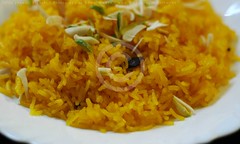
Lunch: Zarda chawal for Prophet Hazrat Muhammad's (sallahu alihi wasalam) Birthday, Karachi
Originally uploaded by Ameer Hamza
My wife today cooked zarda chawal on the eve of Birthday anniversary of Prophet of ALLAH, Hazrat Muhammad (sallahu alihi wasalam). Traditionally Muslims the world over have cooked various sweet dishes to commemorate the Birthday (12th Rabi-ul-Awal Sharif, the 3rd Month of Islamic Lunar calender). We still cook and we ensure that the dish is sweet and tasty. Almonds and pistachio were minutely cut way before the dish was cooked. Food colour was also added to give it a brilliant yellow colour.
Friday, February 3, 2012
Dinner: Burns Road ka Bun Kebab, Karachi
Via Flickr:
Burns Road, is a street in old downtown Karachi, Sindh, Pakistan. Because of different vowels in the Urdu language, it is generally referred to as "Buns Road" by locals. It was named after Dr. James Burnes, a physician who treated the Amirs of Sindh in 1820s.
Burns Road is famous for its traditional food offerings such as Biryani and Karahi, Dhaga Kabab, Fry Kabab, Nihari, Haleem and fried finger fish. More specialties including Kheer, Rabri, Ras Malai, Ras Gulay, Lassi and Dahi Bara. There are a couple of Halwa Puri stalls too which serve Halwa Puri for breakfast.
The famous Lassi shops have been around since post partition period and also serve Milk with dry fruits. They also have Mango Shake (Aam Ki Botal) and Mango ice-cream during Mango season and Gajar Carrot Ka Halwa in winter. They usually open 6 or 7am and stay open till 2am midnight and later on weekends.
Burns Road also boasts of two well known sweets shops, Fresco and Bhashanis; that is a great boon for Desi sweets lovers.
Source: en.wikipedia.org/wiki/Burns_Road
Burns Road, is a street in old downtown Karachi, Sindh, Pakistan. Because of different vowels in the Urdu language, it is generally referred to as "Buns Road" by locals. It was named after Dr. James Burnes, a physician who treated the Amirs of Sindh in 1820s.
Burns Road is famous for its traditional food offerings such as Biryani and Karahi, Dhaga Kabab, Fry Kabab, Nihari, Haleem and fried finger fish. More specialties including Kheer, Rabri, Ras Malai, Ras Gulay, Lassi and Dahi Bara. There are a couple of Halwa Puri stalls too which serve Halwa Puri for breakfast.
The famous Lassi shops have been around since post partition period and also serve Milk with dry fruits. They also have Mango Shake (Aam Ki Botal) and Mango ice-cream during Mango season and Gajar Carrot Ka Halwa in winter. They usually open 6 or 7am and stay open till 2am midnight and later on weekends.
Burns Road also boasts of two well known sweets shops, Fresco and Bhashanis; that is a great boon for Desi sweets lovers.
Source: en.wikipedia.org/wiki/Burns_Road
Thursday, February 2, 2012
Dinner: Safed Paplet (White Pomfret), Karachi
Via Flickr:
Fried with green masala, a local recipe of my mother in a pan with oil. Eaten raw or with roti and piyaz (onions).
Pomfret is known as paplet is perhaps the most popular fish eaten among the Gujrati familes of Pakistan and India, perhaps due the fact that Gujratis have been eating this fish since last few centuries. Best season for fishing pomfret in Arabian Sea is between Sep-Jan, December being the best month. We got this fish for Rs.900/ Kg, which makes it one of the most expensive eatable fish in Pakistan. And this was rather small. Large size was Rs.1,200 / Kg. We call it 'Paplet', a lovely name.
Fried with green masala, a local recipe of my mother in a pan with oil. Eaten raw or with roti and piyaz (onions).
Pomfret is known as paplet is perhaps the most popular fish eaten among the Gujrati familes of Pakistan and India, perhaps due the fact that Gujratis have been eating this fish since last few centuries. Best season for fishing pomfret in Arabian Sea is between Sep-Jan, December being the best month. We got this fish for Rs.900/ Kg, which makes it one of the most expensive eatable fish in Pakistan. And this was rather small. Large size was Rs.1,200 / Kg. We call it 'Paplet', a lovely name.
Wednesday, February 1, 2012
Dinner: Chicken corn soup, Karachi
Via Flickr:
Chicken corn soup flanked by (R to L): White vinegar with green chilies, red chilli sauce and soya sauce. Cooked by my wife.
Chicken corn soup flanked by (R to L): White vinegar with green chilies, red chilli sauce and soya sauce. Cooked by my wife.
Sweets for Prophet's Birthday: Baklava, Karachi
Via Flickr:
Gifted to my father today by Pak Fan company, Pakistan, for the upcoming Birthday of our Beloved Prophet Hazrat Muhammad-e-Mustafa (salahu alihi wasalam), which will appear this Sunday (5th Feb, 2012). According to Sunni Muslims, Birthday of Prophet is 12th Rabi-ul-Awal Sharif, which is the 3rd month of Islamic lunar calender.
In Pakistan and across the world where Muslims reside Birthday is celebrated with recitation of Naats (hyms in praise of Prophet) and Quran Sharif (Holy Book of Islam and Word of ALLAH).
Gifted to my father today by Pak Fan company, Pakistan, for the upcoming Birthday of our Beloved Prophet Hazrat Muhammad-e-Mustafa (salahu alihi wasalam), which will appear this Sunday (5th Feb, 2012). According to Sunni Muslims, Birthday of Prophet is 12th Rabi-ul-Awal Sharif, which is the 3rd month of Islamic lunar calender.
In Pakistan and across the world where Muslims reside Birthday is celebrated with recitation of Naats (hyms in praise of Prophet) and Quran Sharif (Holy Book of Islam and Word of ALLAH).
Dinner: Chargah, Karachi
Via Flickr:
Full chicken cooked with BBQ sauce. Cooked by my wife for dinner.
Full chicken cooked with BBQ sauce. Cooked by my wife for dinner.
Subscribe to:
Posts (Atom)
